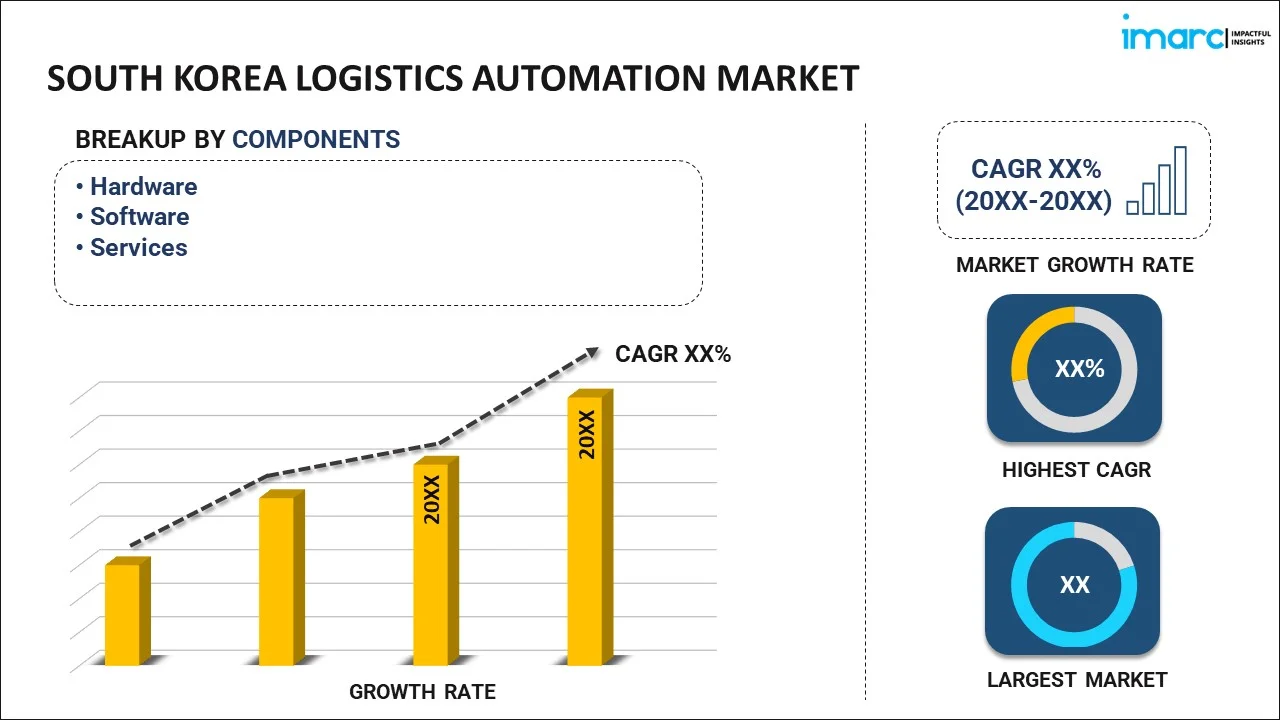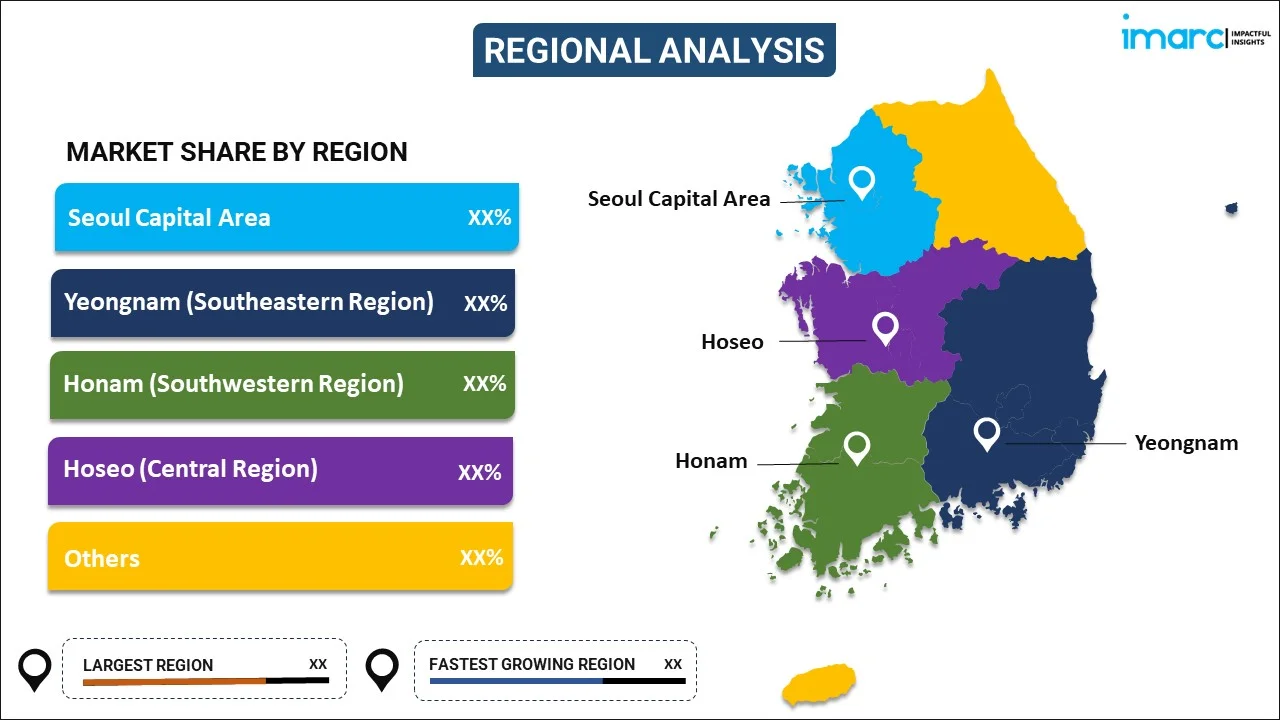
South Korea Logistics Automation Market Report by Component (Hardware, Software, Services), Function (Warehouse and Storage Management, Transportation Management), Enterprise Size (Small and Medium-sized Enterprises, Large Enterprises), Industry Vertical (Manufacturing, Healthcare and Pharmaceuticals, Fast-Moving Consumer Goods (FMCG), Retail and E-Commerce, 3PL, Aerospace and Defense, Oil, Gas and Energy, Chemicals, and Others), and Region 2024-2032
Market Overview:
South Korea logistics automation market size is projected to exhibit a growth rate (CAGR) of 9.80% during 2024-2032. The growing adoption of cutting-edge technologies, including artificial intelligence (AI), internet of things (IoT), and machine learning (ML), rising preferences for efficient and timely deliveries among people, and increasing popularity of collaborative robots (cobots) represent some of the key factors driving the market.
|
Report Attribute
|
Key Statistics
|
|---|---|
|
Base Year
|
2023 |
|
Forecast Years
|
2024-2032
|
|
Historical Years
|
2018-2023
|
| Market Growth Rate (2024-2032) | 9.80% |
Logistics automation is the application of technology and automated systems to optimize various processes involved in the movement, warehouse, and dispersal of goods and services. It consists of various activities, ranging from order processing and inventory management to transportation and delivery. It is implemented through a combination of software solutions and hardware components, such as robotics, conveyor systems, and automated guided vehicles (AGVs). It is available in several types, including warehouse automation, transportation management systems (TMS), and order management systems (OMS), each tailored for specific aspects of the supply chain. It minimizes human errors in tasks, such as data entry and order processing, and facilitates faster and more accurate deliveries. It helps in reducing labor costs, lowering inventory carrying costs, and providing efficient route planning, which contributes to significant cost savings. It ensures high levels of accuracy for fulfillment and inventory management. It can scale with business growth, accommodating increased volumes without major disruptions. It aids in better resource allocation, allowing companies to allocate human labor for more strategic and value-added tasks while automated systems handle routine operations. It finds applications in various industries, including e-commerce, manufacturing, retail, and healthcare.
South Korea Logistics Automation Market Trends:
At present, the rising number of online shopping platforms and preferences for efficient and timely deliveries among people represents one of the crucial factors impelling the market growth in South Korea. The logistics companies are increasingly turning to automation for streamlining their operations. This includes automated warehouses, robotic order picking systems, and intelligent route optimization, which are essential to handle the rise in e-commerce orders. Additionally, the growing adoption of cutting-edge technologies, including artificial intelligence (AI), internet of things (IoT), and machine learning (ML) in logistics automation to real-time data analysis, predictive maintenance, and smart decision-making, is positively influencing the market in the country. Apart from this, the rising support by the governing authorities through financial incentives, subsidies, and regulatory frameworks is encouraging logistics companies to invest in automation. In addition, the increasing popularity of collaborative robots (cobots) for enhancing productivity and safety is supporting the market growth in the country. These cobots are also used in tasks like palletizing, packaging, and quality control, contributing to a more efficient and flexible workforce. Furthermore, the growing preferences for customization and personalization options among individuals are prompting the utilization of automation for efficient handling of customized orders, ensuring that each package is accurately assembled and delivered according to the specifications. Moreover, the rising emergence of just-in-time (JIT) inventory management requires automation to ensure that inventory levels are precisely aligned with demand, minimizing storage costs and reducing excess stock.
South Korea Logistics Automation Market Segmentation:
IMARC Group provides an analysis of the key trends in each segment of the market, along with forecasts at the country level for 2024-2032. Our report has categorized the market based on component, function, enterprise size, and industry vertical.
Component Insights:

- Hardware
- Mobile Robots (AGV, AMR)
- Automated Storage and Retrieval Systems (AS/RS)
- Automated Sorting Systems
- De-palletizing/Palletizing Systems
- Conveyor Systems
- Automatic Identification and Data Collection (AIDC)
- Order Picking
- Software
- Warehouse Management Systems (WMS)
- Warehouse Execution Systems (WES)
- Services
- Value Added Services
- Maintenance
The report has provided a detailed breakup and analysis of the market based on the component. This includes hardware (mobile robots (AGV, AMR), automated storage and retrieval systems (AS/RS), automated sorting systems, de-palletizing/palletizing systems, conveyor systems, automatic identification and data collection (AIDC), and order picking), software (warehouse management systems (WMS) and warehouse execution systems (WES)), and services (value added services and maintenance).
Function Insights:
- Warehouse and Storage Management
- Transportation Management
A detailed breakup and analysis of the market based on function have also been provided in the report. This includes warehouse and storage management and transportation management.
Enterprise Size Insights:
- Small and Medium-sized Enterprises
- Large Enterprises
The report has provided a detailed breakup and analysis of the market based on the enterprise size. This includes small and medium-sized enterprises and large enterprises.
Industry Vertical Insights:
- Manufacturing
- Healthcare and Pharmaceuticals
- Fast-Moving Consumer Goods (FMCG)
- Retail and E-Commerce
- 3PL
- Aerospace and Defense
- Oil, Gas and Energy
- Chemicals
- Others
A detailed breakup and analysis of the market based on industry vertical have also been provided in the report. This includes manufacturing, healthcare and pharmaceuticals, fast-moving consumer goods (FMCG), retail and e-commerce, 3PL, aerospace and defense, oil, gas and energy, chemicals, and others.
Regional Insights:

- Seoul Capital Area
- Yeongnam (Southeastern Region)
- Honam (Southwestern Region)
- Hoseo (Central Region)
- Others
The report has also provided a comprehensive analysis of all the major regional markets, which include Seoul Capital Area, Yeongnam (Southeastern Region), Honam (Southwestern Region), Hoseo (Central Region), and Others.
Competitive Landscape:
The market research report has also provided a comprehensive analysis of the competitive landscape in the market. Competitive analysis such as market structure, key player positioning, top winning strategies, competitive dashboard, and company evaluation quadrant has been covered in the report. Also, detailed profiles of all major companies have been provided.
South Korea Logistics Automation Market Report Coverage:
| Report Features | Details |
|---|---|
| Base Year of the Analysis | 2023 |
| Historical Period | 2018-2023 |
| Forecast Period | 2024-2032 |
| Units | US$ Million |
| Scope of the Report | Exploration of Historical and Forecast Trends, Industry Catalysts and Challenges, Segment-Wise Historical and Predictive Market Assessment:
|
| Components Covered |
|
| Functions Covered | Warehouse and Storage Management, Transportation Management |
| Enterprise Sizes Covered | Small and Medium-sized Enterprises, Large Enterprises |
| Industry Verticals Covered | Manufacturing, Healthcare and Pharmaceuticals, Fast-Moving Consumer Goods (FMCG), Retail and E-Commerce, 3PL, Aerospace and Defense, Oil, Gas and Energy, Chemicals, Others |
| Regions Covered | Seoul Capital Area, Yeongnam (Southeastern Region), Honam (Southwestern Region), Hoseo (Central Region), Others |
| Customization Scope | 10% Free Customization |
| Report Price and Purchase Option | Single User License: US$ 3699 Five User License: US$ 4699 Corporate License: US$ 5699 |
| Post-Sale Analyst Support | 10-12 Weeks |
| Delivery Format | PDF and Excel through Email (We can also provide the editable version of the report in PPT/Word format on special request) |
Key Questions Answered in This Report:
- How has the South Korea logistics automation market performed so far and how will it perform in the coming years?
- What has been the impact of COVID-19 on the South Korea logistics automation market?
- What is the breakup of the South Korea logistics automation market on the basis of component?
- What is the breakup of the South Korea logistics automation market on the basis of function?
- What is the breakup of the South Korea logistics automation market on the basis of enterprise size?
- What is the breakup of the South Korea logistics automation market on the basis of industry vertical?
- What are the various stages in the value chain of the South Korea logistics automation market?
- What are the key driving factors and challenges in the South Korea logistics automation?
- What is the structure of the South Korea logistics automation market and who are the key players?
- What is the degree of competition in the South Korea logistics automation market?
Key Benefits for Stakeholders:
- IMARC’s industry report offers a comprehensive quantitative analysis of various market segments, historical and current market trends, market forecasts, and dynamics of the South Korea logistics automation market from 2018-2032.
- The research report provides the latest information on the market drivers, challenges, and opportunities in the South Korea logistics automation market.
- Porter's five forces analysis assist stakeholders in assessing the impact of new entrants, competitive rivalry, supplier power, buyer power, and the threat of substitution. It helps stakeholders to analyze the level of competition within the South Korea logistics automation industry and its attractiveness.
- A competitive landscape allows stakeholders to understand their competitive environment and provides an insight into the current positions of key players in the market.
Need more help?
- Speak to our experienced analysts for insights on the current market scenarios.
- Include additional segments and countries to customize the report as per your requirement.
- Gain an unparalleled competitive advantage in your domain by understanding how to utilize the report and positively impacting your operations and revenue.
- For further assistance, please connect with our analysts.
 Inquire Before Buying
Inquire Before Buying
 Speak to an Analyst
Speak to an Analyst
 Request Brochure
Request Brochure
 Request Customization
Request Customization




.webp)




.webp)












